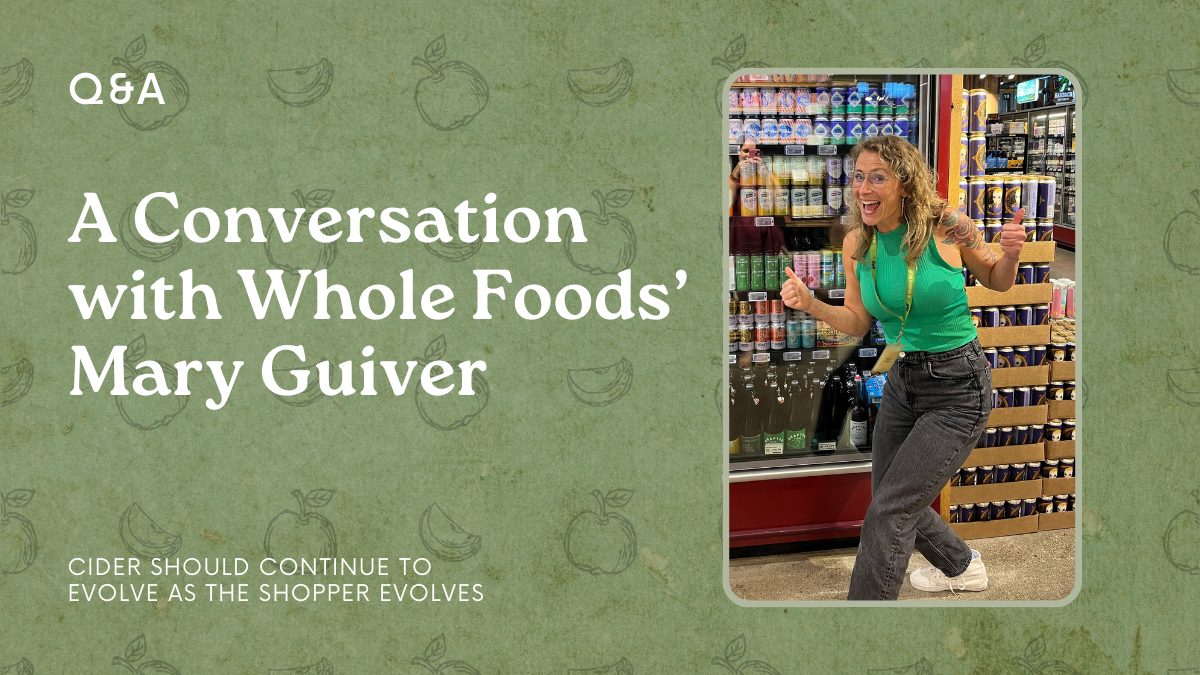A conversation with Whole Foods’ Mary Guiver
As Whole Foods’ principle beer category merchant, Mary Guiver is responsible not only for the performance of the supermarket chain’s craft, domestic and imported beer quality standards and sales, but also for its fourth or “beyond beer” category. This growing category includes beverages such as nonalcoholic beer, hard seltzer, hard kombucha and hard teas — and, of course, cider. To stay relevant on limited and busy shelves, “both consistency and evolution are extremely important,” Guiver says. “Cider should continue to evolve as the shopper evolves.”
A proponent of the drink, Guiver says savvy cidermakers and merchants would be foolish to think stiff competition means counting the product out. In fact, she believes cider is having its moment. “Our customers are looking for high quality and local relevance,” says Guiver. In this exclusive interview with Cidercraft, Guiver discusses why this moment is happening and how to capitalize on the opportunity.
Cidercraft: During 2023 CiderCon, you said “this is cider’s moment.” Can you elaborate on what that means to you?
Mary Guiver: When I mentioned this being “cider’s moment,” it was based on the intersection around the rich history of cider and its healthy attributes compared to other adult beverages. Cider is great for people looking to drink in moderation with a lower ABV, and the living nature of cider, which is fermented and not distilled, has more and more consumers gravitating toward it. Price point and approachability compared to wine is also something to note. When you compare the two, wine has a stigma that cider does not. Cider tasting rooms often feel more approachable than a winery and cider has more single-serve options. If you compare beer and cider, cider has no gluten, ingredient transparency and nutritional labels working in its favor.
Overall, cider has perhaps more of a community aspect than other adult beverage categories, as well as an agricultural element that more and more customers are taking an interest in right now. You can directly connect cider with the fruit it comes from, which is something the next generation is seeking and is a trend we are spotting in adult beverage consumption.
CC: How does Whole Foods pick which ciders to stock?
MG: Cider has really limited shelf space compared to other larger categories, but the way we frame every category in-store is customer focused. We start by making sure we have top sellers. In some stores this is a national brand, but in others it could be a regional or local brand. The remaining space is for the regional team to fill, and they look at who the cider shopper is in their specific market so we can showcase ciders that represent those customers. We’ll also take a few different factors into consideration , including quality, format and style. Finally, we always leave room for what we call “flex space.” This is where a local store can bring in a new cider that they are excited about.
CC: What’s your advice to cideries looking to earn a Whole Foods placement?
MG: Our team is very small, so if your brand can only supply one to two stores with product, it is best to work with those stores directly. If you are looking to supply more stores you can head to the Whole Foods Market Supplier Portal and let it guide you on our transparent review process with tools to use along the way. Since quality is a very important part of our onboarding process, it is also imperative that potential suppliers read through the quality standards guidelines for ciders to make sure their product aligns.
CC: How can cidermakers offer value to the consumer in terms of packaging?
MG: Ciders offer value by presenting the customer with many different price points and formats for every occasion. Label transparency is another huge benefit cider has going for it. Questions like how or where the apples are grown can be answered right in front of the consumer, which is something the Whole Foods Market customer can be really passionate about. Cider has the benefit of being transparent and connected to agriculture in a way that many other adult beverage categories don’t. If you want a beautiful bottle on your Thanksgiving table, you don’t have to provide a high-end bottle of wine for guests. Instead, grab a cider bottle that will pair well with the food and be approachable for guests.
CC: What’s an example of how Whole Foods champions cider?
MG: We empower our regional team members to innovate with local cider brands to create unique collaborations only available in our stores. For example, we collaborated with Wölffer Estate to create a hibiscus rosé cider that launched this spring. We’re also working on a new in-store program for October 2023 that will highlight cider throughout this apple harvest month.
CC: In what ways have you seen cider evolve over the course of your career?
MG: When I started, there was not a ton happening in the craft cider space. Offerings were mostly sweet and cans were not the main format yet. A lot of cider’s evolution with canned formats has happened around the same time as craft beer, which is interesting to note. But what I am most excited about is the customer’s recent interest in the history of ciders. We are seeing some domestic-based cideries experiment with more traditional American heritage, Basque and Normandy styles, which are often drier and funkier. With that comes some educational hurdles, but the spectrum of ciders out there is starting to rival the craft beer scene. It is a whole new world of more dynamic ciders that I am personally super excited to learn more about!
Story featured in the 2023 Cider State of the Industry Hard Cider Report. To order a print copy click here.






